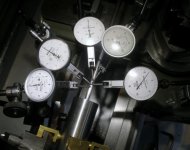Dusty Stevens
Hollow Point Dispenser
Thats real nice. I need one for my 13" south bend
Mike
p.s. I have also re-thought the knurling on the reamer holder and will likely only have the very end left with a pattern on it. Don't want any reason for the tool to be in my hand any longer than need be if something goes wrong! It just made it easier to screw it into the body of the holder.
Are you talking about barrel stress?"one of the guys caught his sleeve on a protruding block welded on the side of a pipe he was polishing on a Monarch 10EE"
No sleeves, no rings, no watches. Apron has a velcro tab that is under the primary material.
So is there a way to avoid the stress being induced as mentioned in the other thread?
Mike
"one of the guys caught his sleeve on a protruding block welded on the side of a pipe he was polishing on a Monarch 10EE"
No sleeves, no rings, no watches. Apron has a velcro tab that is under the primary material.
So is there a way to avoid the stress being induced as mentioned in the other thread?
Mike
Some people use a piece of copper wire between the barrel and chuck so the barrel does not deflect. I use an aluminum ring that I machined and cut with a slitting saw.
Ben

confused: barrel constantly slides to relieve the twisting it endures.
I am confused as to barrel sliding and twisting. I can put a .0001 test indicator ( Brown & Sharpe 7023-3) on Deltronic fitted pin in the bore or on a turned tenon or on the flat spot near the 4 jaw chuck at the head stock after I have indicated the barrel in to the nearest .0001. Then turn the barrel by hand or in back gear or at a speed of 304 RPM /470 RPM / 740 RPM and the indicator needle barely wiggles less then .0001 most but less then .0002 anytime.So please someone explain to what and when is the barrel sliding and twisting.
I know that I am not a Machinist but I know that I know how to set up and read an indicator and how to test one to see is it is reading right.
Here is one of my testing of indicators so that I can trust what I am reading.
Chet
View attachment 15912
So please someone explain to what and when is the barrel sliding and twisting.

